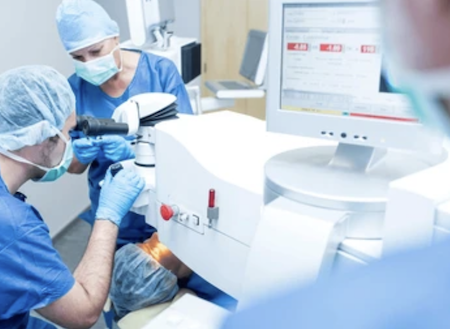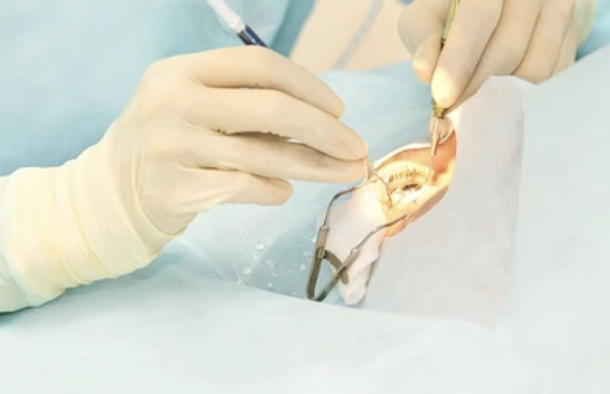
Laser Eye Surgery in Turkey
Tired of those glasses and want to get rid of them somewhere that will take care of your needs and give your eyes the quality they deserve?
You are in the right place.
Lasers are cool to mess with your pet with, but laser can also be very cool because a beam of which at the right intensity can cure your nearsightedness (myopia), farsightedness (hyperopia) and astigmatism by reshaping your cornea. This type of surgery is called refractive surgery, and it takes in the hands of Tour for Cure experts from only a couple of seconds to a few minutes. It is a great way to save the money you spend on glasses or the time you waste putting on your lenses every day.
Laser eye surgery is an incredible innovation in vision correction, offering a way to achieve clearer vision without the hassle of glasses or contact lenses. In Türkiye, the world’s leading medical tourism destination, you have access to the latest laser eye surgery technologies, including LASIK, Femto LASIK, PRK/LASEK, and ReLEx SMILE. These cutting-edge procedures are performed by highly skilled surgeons in state-of-the-art clinics, ensuring a safe and effective experience. Whether you're near-sighted, far-sighted, or have astigmatism, there's a laser treatment for you!
How it works?
The first step is to determine your eligibility for one of the refractive surgery types (see below). And don’t worry if you are not fit for laser surgery; you might be a perfect match for a lens implant. Eligibility is determined during an examination of your eyes and your medical history, and then, if you are good to go, further tests are done to map your cornea and define the parameters of the surgery.
After the examination and the preparations, our experts will guide you to choosing one of the laser surgeries described below and prepare you for the surgery to be performed on the next day and give you some instructions to ensure the safety of the FDA-approved procedure (that is totally painless thanks to the inventor of anesthetic eye drops).
After the surgery, our professionals will give you some hints on how to care for your newly-acquired visual acuity and your eyes for the next few days after surgery and then send you on to enjoy your fresh, HD life.
The Revolutionary Vision Correction Surgeries
Types of Laser Eye Surgery Available in Türkiye
1. LASIK Surgery (Laser-Assisted in Situ Keratomileusis)
What is LASIK? LASIK is the most popular and widely known laser eye surgery. It is a fast, safe, and effective procedure that can treat nearsightedness, farsightedness, and astigmatism. The procedure involves using a laser to reshape the cornea, enabling light to focus correctly on the retina for clearer vision.
How Does LASIK Work? LASIK involves two main steps:
A small flap is created in the cornea, usually using a microkeratome blade or a femtosecond laser.
An excimer laser is then used to reshape the underlying corneal tissue, correcting the refractive error.
Benefits of LASIK:
Quick recovery time (usually within 24-48 hours)
Minimal discomfort
Significant improvement in vision within hours
Ideal for patients with moderate refractive errors

2. Femto LASIK (Femtosecond Laser-Assisted LASIK)
What is Femto LASIK? Femto LASIK is a more advanced, bladeless version of traditional LASIK surgery. It uses a femtosecond laser to create the corneal flap instead of a mechanical blade. This laser is incredibly precise and minimizes the risk of complications, offering a higher level of safety and accuracy than conventional LASIK.
How Does Femto LASIK Work? Similar to LASIK, Femto LASIK reshapes the cornea to correct vision. However, the key difference is the use of the femtosecond laser to create the corneal flap. This laser is more accurate and allows for a thinner, more precise flap.
Benefits of Femto LASIK:
Increased precision and safety
No blades, reducing the risk of complications
Faster recovery with minimal discomfort
Ideal for patients with thin corneas or irregular eye shapes
3. PRK/LASEK (Photorefractive Keratectomy / Laser-Assisted Subepithelial Keratectomy)
 What are PRK and LASEK? PRK and LASEK are both surface-based laser eye surgery techniques designed to treat refractive errors like nearsightedness, farsightedness, and astigmatism. Unlike LASIK and Femto LASIK, PRK and LASEK do not involve creating a corneal flap. Instead, the outer layer of the cornea (the epithelium) is removed, and the laser reshapes the cornea beneath it.
What are PRK and LASEK? PRK and LASEK are both surface-based laser eye surgery techniques designed to treat refractive errors like nearsightedness, farsightedness, and astigmatism. Unlike LASIK and Femto LASIK, PRK and LASEK do not involve creating a corneal flap. Instead, the outer layer of the cornea (the epithelium) is removed, and the laser reshapes the cornea beneath it.
PRK: In PRK, the epithelium is completely removed before the cornea is reshaped with a laser.
LASEK: LASEK is similar but involves preserving the epithelium, which is loosened with an alcohol solution and then repositioned after surgery.
How Do PRK and LASEK Work? Both procedures use an excimer laser to reshape the cornea. The main difference between the two is the way the epithelium is handled, with PRK removing it entirely and LASEK preserving it for a gentler healing process.
Benefits of PRK/LASEK:
- Ideal for patients with thin corneas who may not be candidates for LASIK
No risk of flap-related complications
A safe and effective option for people with higher prescriptions or irregular corneal shapes
Longer recovery time than LASIK or Femto LASIK, but results are just as effective
4. ReLEx SMILE (Small Incision Lenticule Extraction)
What is ReLEx SMILE? ReLEx SMILE is one of the newest and most advanced laser eye surgery techniques. Unlike LASIK or Femto LASIK, ReLEx SMILE does not involve creating a corneal flap. Instead, a small lenticule (a disc-shaped piece of tissue) is removed from the cornea through a tiny incision, reshaping the cornea to correct vision.
How Does ReLEx SMILE Work? A femtosecond laser is used to create a lenticule inside the cornea. A small incision is then made on the surface of the cornea, through which the lenticule is extracted. This reshapes the cornea, allowing light to focus correctly on the retina.
Benefits of ReLEx SMILE:
No corneal flap is created, reducing the risk of flap-related complications
Minimal invasiveness with just a small incision
Faster recovery time and less discomfort compared to LASIK
Ideal for patients with higher degrees of myopia or astigmatism
Safe for people with dry eyes as it does not disturb the corneal nerves as much
Why Choose Laser Eye Surgery in Türkiye?
Türkiye has become a global hub for high-quality, affordable laser eye surgeries. Here's why many people choose Türkiye for their eye care needs:
Cutting-Edge Technology: Clinics in Türkiye use the latest advancements in laser technology, offering all four types of surgeries: LASIK, Femto LASIK, PRK/LASEK, and ReLEx SMILE. These technologies provide exceptional results with minimal risk and fast recovery.
Affordable Costs: Laser eye surgery in Türkiye costs significantly less than in many Western countries. Despite the lower price, the quality of care is top-notch, thanks to expert surgeons and advanced technology.
Experienced Surgeons: Türkiye is home to highly skilled ophthalmologists who specialize in laser vision correction. Many of them have trained internationally and have years of experience performing these surgeries.
Tourism and Recovery: Türkiye offers a perfect blend of medical care and vacation. After your surgery, you can enjoy a relaxing recovery while exploring the rich history and stunning landscapes of places like Istanbul, Cappadocia, and the Turkish Riviera.
How to Choose the Right Laser Eye Surgery Technique for You?
Choosing the right laser eye surgery depends on your specific needs and the health of your eyes. Here’s how you can decide which technique is best for you:
LASIK and Femto LASIK are ideal for patients with mild to moderate refractive errors who have healthy corneas.
PRK and LASEK are better suited for people with thin corneas or those who are not candidates for LASIK.
ReLEx SMILE is perfect for those with higher prescriptions or those seeking a minimally invasive procedure with faster recovery.
A thorough consultation with an experienced eye surgeon is essential to determine which procedure will provide you with the best results.
What to Expect Before, During, and After Your Laser Eye Surgery in Türkiye?
Before the Procedure: You’ll have a detailed consultation with your surgeon, who will assess your eye health and discuss which laser surgery is best for you. Expect to undergo several tests, including eye measurements and corneal scans.
During the Procedure: Most laser eye surgeries are performed under local anesthesia, meaning you'll be awake but won’t feel pain. The procedure typically takes between 10 to 30 minutes, depending on the type of surgery.
After the Procedure: You’ll need a short recovery period before being discharged. Your doctor will provide aftercare instructions, including eye drops and follow-up appointments. Most patients experience improved vision within a few days, although full healing may take a few weeks.
Book Your Laser Eye Surgery in Türkiye Today!
Ready to see the world more clearly? Contact Tour for Cure today to schedule your free consultation for LASIK, Femto LASIK, PRK/LASEK, or ReLEx SMILE surgery in Türkiye. Our team of world-class surgeons is here to help you achieve your vision goals with the latest laser technology.